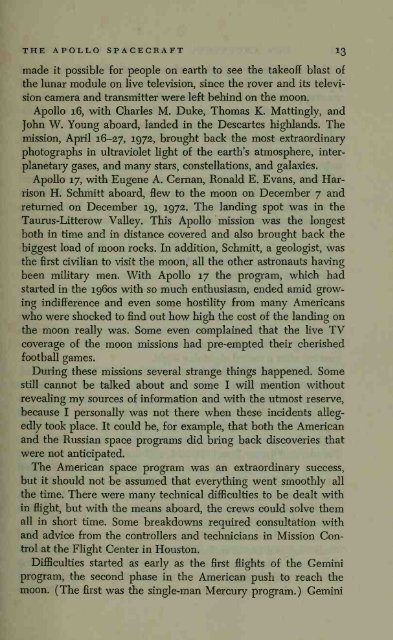Create successful ePaper yourself
Turn your PDF publications into a flip-book with our unique Google optimized e-Paper software.
THE APOLLO SPACECRAFT<br />
I3<br />
made it possible for people on earth to see the takeoff blast of<br />
the lunar module on live television, since the rover and its<br />
television<br />
camera and transmitter were left behind on the moon.<br />
Apollo 16, with Charles M. Duke, Thomas K. Mattingly, and<br />
John W. Young aboard, landed in the Descartes highlands. The<br />
mission, April 16-27, 1972, brought back the most extraordinary<br />
photographs in ultraviolet Hght of the earth's<br />
atmosphere, interplanetary<br />
gases, and many stars, constellations, and galaxies.<br />
Apollo 17, with Eugene A. Ceman, Ronald E. Evans, and Harrison<br />
H. Schmitt aboard, flew to the moon on December 7 and<br />
returned on December 19, 1972. The landing spot was in the<br />
Taurus-Litterow Valley. This Apollo mission was the longest<br />
both in time and in distance covered and also brought back the<br />
biggest load of moon rocks. In addition, Schmitt, a geologist, was<br />
the first civilian to visit the moon, all the other astronauts having<br />
been military men. With Apollo 17 the program, which had<br />
started in the 1960s with so much enthusiasm, ended amid growing<br />
indifference and even some hostility from many Americans<br />
who were shocked to find out how high the cost of the landing on<br />
the moon really was. Some even complained that the live TV<br />
coverage of the moon missions had pre-empted their<br />
cherished<br />
football games.<br />
During these missions several strange things happened. Some<br />
still cannot be talked about and some I will mention without<br />
revealing my sources of information and with the utmost reserve,<br />
because I personally was not there when these incidents allegedly<br />
took place. It could be, for example, that both the American<br />
and the Russian space programs did bring back discoveries that<br />
were not anticipated.<br />
The American space program was an extraordinary success,<br />
but it should not be assumed that everything went smoothly all<br />
the time. There were many technical difficulties to be dealt with<br />
in flight, but with the means aboard, the crews could solve them<br />
all in short time. Some breakdowns required consultation with<br />
and advice from the controllers and technicians in Mission Control<br />
at the Flight Center in Houston.<br />
Difficulties started as early as the first flights of the Gemini<br />
program, the second phase in the American push to reach the<br />
moon. ( The first was the single-man Mercury program. ) Gemini

















